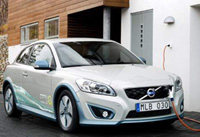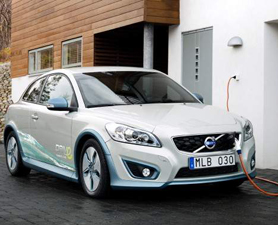 Volvo is experimenting with a new composite material that can store and release energy more quickly than a convention lithium-ion battery.
Volvo is experimenting with a new composite material that can store and release energy more quickly than a convention lithium-ion battery.
The biggest challenge for battery electric vehicles is clearly the cost and the weight of today's lithium-ion battery packs.
Volvo is experimenting with a new composite material that can store and release energy more quickly than a convention lithium-ion battery.
The biggest challenge for battery electric vehicles is clearly the cost and the weight of today's lithium-ion battery packs.
Now Volvo is experimenting with a new composite material that can store and release energy more quickly than a convention lithium-ion cell and, it says, might one day replace steel for making auto body panels.
European Consortium
The material is being developed by a consortium of nine European companies and organizations, launched by the
The team will initially focus just on developing the material, composed of carbon fibers and polymer resin. It is said to be both strong and pliant, meaning it can be shaped as necessary--which could allow it to replace steel panels on future cars, lightening the body structure to improve overall efficiency.
It could also do double duty for hybrids and plug-in vehicles, cutting the size and weight of the car's lithium battery.
Included in the research will be ways to make the material practical for large-scale industrial production. Unlike steel panels, which can be stamped out at thousands of pieces per hour, carbon fiber to date has been largely hand-laid into molds--although many automakers and suppliers are working to overcome this problem.
the research will be ways to make the material practical for large-scale industrial production. Unlike steel panels, which can be stamped out at thousands of pieces per hour, carbon fiber to date has been largely hand-laid into molds--although many automakers and suppliers are working to overcome this problem.
Spare-Tire
The project's ultimate goal is to replace a test vehicle's steel spare-wheel well stamping with a similar piece made of the new material. It couldn't store a great deal of energy, but it would be enough, Volvo says, to restart the engine of a hybrid vehicle when it needs to move away from a stoplight.
Volvo calculated that if the car's steel body panels were replaced by the lighter material, that alone could cut the weight of the vehicle by 15 percent. And that's before the energy storage benefits. Thus far, the sole upcoming production vehicle known to have a carbon-fiber structure is the 2014 BMW
EV Experiments
Like most other carmakers, Volvo is experimenting with a small fleet of battery electric vehicles to gain real-world usage data. It will build 50 of its C30 hatchbacks converted to battery power, offering up to 90 miles of range, but does not intend to test them in the United States market.
The
For more information on the project, the

 Previous page
Previous page Back to top
Back to top







